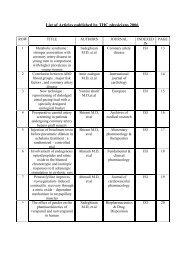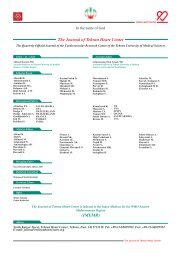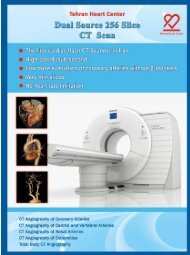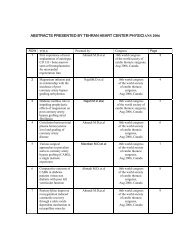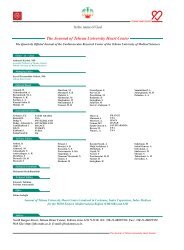Metabolic Syndrome: Stronger association With Coronary Artery
Metabolic Syndrome: Stronger association With Coronary Artery
Metabolic Syndrome: Stronger association With Coronary Artery
Create successful ePaper yourself
Turn your PDF publications into a flip-book with our unique Google optimized e-Paper software.
Register or Login: Password: () Athens<br />
Login<br />
New<br />
Bookmark page<br />
Search Forms<br />
Quick Search<br />
Advanced Search<br />
Field Search<br />
Drug Search<br />
Disease Search<br />
Article Search<br />
Search Results<br />
Session Results<br />
Clipboard<br />
Saved Clipboards<br />
E-mail Alerts<br />
Saved Searches<br />
Session Result/ Record 3 of 9<br />
Full Record<br />
Record<br />
3<br />
Related Articles |<br />
Add to Clipboard Back to results Previous record Next record<br />
Hemodynamic performance of the aortic prosthesis<br />
by stress echocardiography<br />
Sadeghian H., Kamangari A., Marzban M., Hossein Mandegar M.,<br />
Darvish S. and Fallah N.<br />
Chirurgia 2006 19:6 (427-430)<br />
Aim. To study the effect of prosthetic aortic valve size on<br />
hemodynamic performance at rest and after exercise. Methods.<br />
Twelve patients (mean age 40.5 years) who had underwent aortic<br />
valve replacement (AVR) 61 months ago because of severe aortic<br />
stenosis were evaluated. Results. Nine patients received St-Jude and<br />
3 patients received other types of prosthetic valves .Sixty percent of<br />
patients had ideal hemodynamic results at rest and peak exercise<br />
(group A1), 42% of patients had good hemodynamic results at rest<br />
but inappropriate at peak exercise (group A2) and 42% of patients<br />
had inappropriate hemodynamic results at rest (group B). Patient<br />
annulus index is significantly different between group A1 and B but<br />
the difference of annulus index between group AI and AII has a trend<br />
for being significant Peak gradient and mean gradient increased<br />
significantly with exercise. Decreases of effective orifice area,<br />
effective orifice area index and performance index were also<br />
significant at peak exercise. None of our 12 patients had mismatch at<br />
rest, but 6 patients had mismatch at stress. Patient annulus index<br />
has a significant correlation with mismatch at peak exercise.<br />
Conclusions. According to this study, we may consider aortic root<br />
enlargement when the patient annulus index is small.



